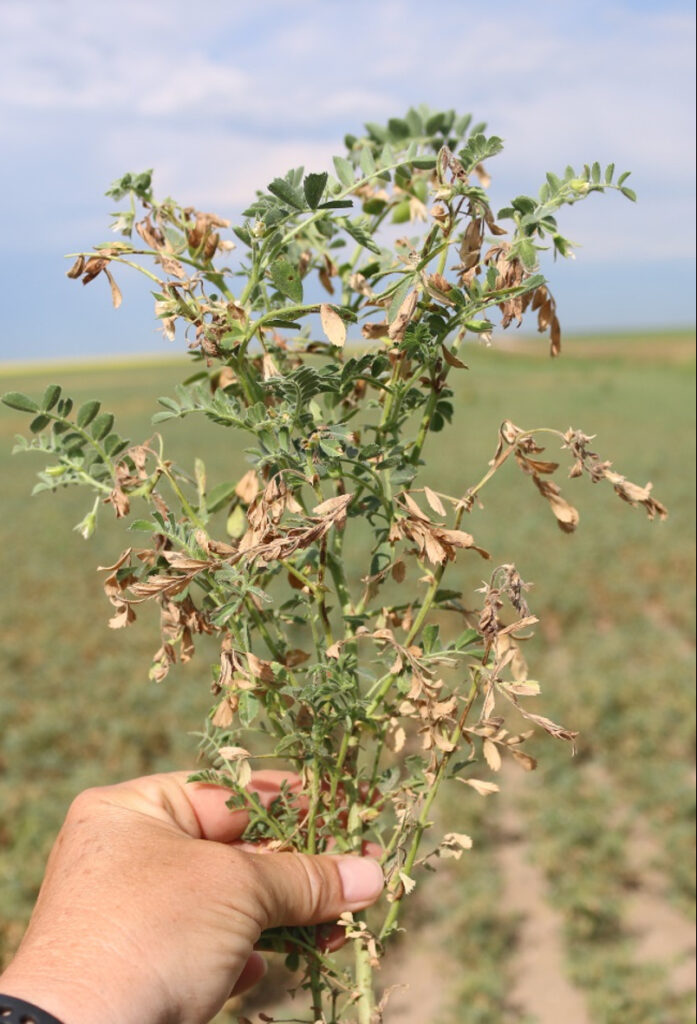
Features
Pulses
Top Crop Summit
Top Crop Summit series: Update on chickpea health
April 5, 2024 By Bruce Barker
 More severe symptoms of the health issue result in branch die-back Courtesy of Sask Pulse Growers
More severe symptoms of the health issue result in branch die-back Courtesy of Sask Pulse Growers Michelle Hubbard is a research scientist with Agriculture and Agri-Food Canada at Swift Current, Sask. At the Top Crop Summit on Feb. 27-28 in Saskatoon, she shared results from a 2023 survey of commercial chickpea fields. She discussed past and on-going trials that study the impacts of the herbicide metribuzin and drought, interactions of drought, chickpea variety and Ascochyta blight, interactions between soils in which symptomatic or asymptomatic chickpea have grown and the impact of drought on chickpea health and metabolites.
An emerging chickpea health issue was identified in 2019 in southern Saskatchewan. The numerous symptoms included leaf tip chlorosis, necrosis, branch wilting and tip wilting. In some cases, the issue resulted in total devastation of plant stands.
The cause was unknown, and suspected causes could have been related to Ascochyta blight, root rot, wilt disease, viruses, herbicides, nutrient stress, nematodes, nodule-feeding insects or drought followed by moisture, or a combination of them.
Field surveys were conducted in southern Saskatchewan from 2019 through 2023 to assess symptoms and to collect samples and agronomic information from producers. Assessment for root rot in 2020 and 2021 found Fusarium redolans, F. solani and F. avenaceum were the most common pathogens. F. avenaceum caused the most disease. Not detected were F. oxysporum f. sp. ciceris, Phytophthora spp., and Verticillium albo-atrum, which can cause wilt in chickpea.
A new pathogen on chickpea, Verticillium dahliae, was found in 2021. In growth chamber trials, symptoms were consistent with the emerging health issue. However, many chickpeas with the symptoms did not have V. dahliae detected.
Healthy and unhealthy tissue samples were assessed for micronutrient concentrations. There wasn’t any difference in concentrations for zinc, manganese, iron, copper and aluminum between healthy and unhealthy plants.
In the 2021 survey, application of metribuzin slightly but significantly increased the disease symptoms from a disease severity of two to 2.6 on a scale of zero to five.
In 2022, symptoms were mild with an average severity rating of 1.6 on the 29 fields surveyed. Pod scarring was noticed late in the season along with Ascochyta blight. The 2023 survey included 38 fields with an average severity rating of 1.77 on all fields with the disease. The date of sampling also impacted the severity rating with higher severity as the season progressed from late June to late July.
Research in 2023 found no differences in the number of nematodes in the soil between healthy and unhealthy fields. A new spiral nematode of an unknown species was identified in the research.
In 2023, disease severity decreased slightly as seeding rate rose from 120 to 180 pounds per acre, but the relationship was very weak. Disease severity was also higher on B-90 (one field) and CDC Leader (eight fields). Past research, though, found no clear conclusions on seed lot experiments.
A greenhouse trial led by Victoria Marchesini at AAFC Swift Current looked at the interaction of drought and healthy and unhealthy soils. These soils were collected from the regional variety trials in Redvers, Sask. Unhealthy soils were collected from plots where the disease was found, while healthy soil was collected from healthy plots. Chickpea was grown in these soils with three watering regimes of well-watered, moderate drought and severe drought.
The results of these greenhouse trials found no emerging health symptoms. There were also no differences in root rot severity between the soils. Future plans for this research include analyzing metabolites, roots and shoots to gain a better understanding of drought impacts on chickpea. Soil will also be analyzed for nutrients and toxins.
In field trials, the application of metribuzin tended to make Ascochyta blight worse. The symptoms were sometimes consistent with the emerging health issue.
Overall, the cause of the health issue remains unclear. Factors that can sometimes mimic symptoms in the greenhouse include V. dahliae, metribuzin x ascochyta interaction and nematodes. More exploration is needed on drought impacts, V. dahliae, nematodes, variety susceptibility and the interaction of these factors.